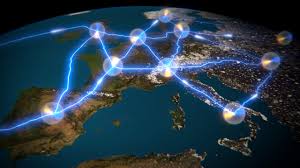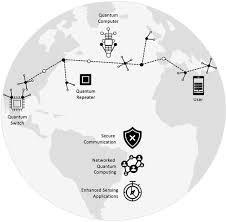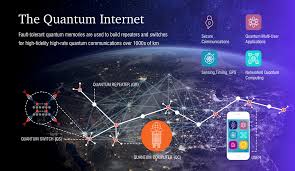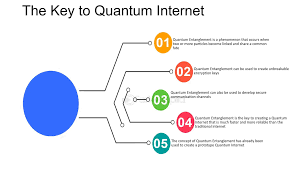
Introduction
The Quantum Internet is a transformative technology that utilizes the principles of quantum mechanics to fundamentally change how data is transmitted and processed. Unlike traditional internet systems, which are built on classical physics, the quantum internet operates using quantum bits (qubits), leveraging phenomena such as superposition and entanglement. These quantum properties allow for radically improved performance in terms of speed, security, and efficiency. As this technology progresses, the quantum internet promises to not only revolutionize communication networks but also redefine computing capabilities.
Key Principles of Quantum Internet
- Quantum Entanglement:
Quantum entanglement is one of the most fascinating aspects of quantum mechanics. It allows two particles, such as photons, to be instantaneously connected across any distance. When the state of one particle is altered, the other responds simultaneously. This phenomenon is utilized in the quantum internet to facilitate quantum teleportation, where information can be transmitted without physically sending the data through conventional means. This enables instantaneous communication between distant locations. - Superposition:
Superposition refers to the ability of quantum particles to exist in multiple states at once, unlike classical bits that are either 0 or 1. A qubit, for instance, can be both 0 and 1 at the same time, allowing quantum computers and networks to process vast amounts of data simultaneously. This property, applied to the quantum internet, would make data transmission much faster, as multiple pieces of information can be encoded and transmitted at once. - Quantum Cryptography:
One of the most exciting potential applications of the quantum internet is in quantum cryptography. Through Quantum Key Distribution (QKD), quantum encryption methods can be used to create communication systems that are secure against any hacking attempt. If someone tries to eavesdrop on a quantum communication, the act of observing the quantum state will disturb it, alerting the sender and receiver immediately. This provides a level of security that is theoretically unbreakable, ensuring the integrity of sensitive information.

Applications of Quantum Internet
- Enhanced Security:
The use of quantum encryption guarantees secure communication that is impervious to traditional hacking methods. Quantum encryption will be pivotal in sectors where security is crucial, such as in banking, defense, and healthcare. Quantum Key Distribution will enable secure data transmission over public channels without the risk of interception. - Distributed Quantum Computing:
Quantum computing systems require enormous computational power, and the quantum internet can facilitate distributed quantum computing. Multiple quantum computers, spread across different locations, could be interconnected through the quantum network, enabling them to solve complex problems much faster than individual machines. This collaboration could lead to advancements in fields like artificial intelligence, drug discovery, and climate modeling. - Faster Data Transmission:
Quantum networks could potentially achieve ultra-fast data transmission by exploiting quantum entanglement and superposition. Unlike classical systems, where data transmission is limited by the speed of light, quantum networks may allow for nearly instantaneous data transfer over long distances, drastically reducing latency in global communications. - Global Quantum Communication Network:
The quantum internet could create a global quantum communication network that connects people, institutions, and businesses across the world. This network would provide ultra-secure, high-speed communication services, transforming industries such as telecommunications, banking, and data centers, while also enabling faster and more reliable international cooperation.

Challenges and Future Outlook
- Technical Challenges:
Although quantum internet is an exciting prospect, numerous technical challenges remain. Quantum systems are highly sensitive, and maintaining quantum states over long distances or extended periods is a difficult task. Developing reliable quantum routers and repeaters to transmit quantum information over large distances is a key challenge in building a quantum internet. - Infrastructure Development:
To establish a global quantum internet, massive changes to existing communication infrastructure will be needed. The deployment of quantum fiber-optic cables and quantum satellites will be crucial in establishing long-distance quantum networks. Moreover, integrating these new systems with the current classical internet infrastructure will require advanced hybrid technologies capable of managing both quantum and classical communication methods. - Standardization and Regulation:
As quantum internet technology develops, there will be a need for global standards and regulations to ensure compatibility between different systems, as well as to address privacy, security, and ethical concerns. Developing regulatory frameworks that account for the unique nature of quantum communication will be critical for smooth global adoption.

Conclusion
The quantum internet represents a bold leap forward in the evolution of communication and computing technology. By leveraging the unique principles of quantum mechanics, such as superposition, entanglement, and quantum cryptography, the quantum internet promises to offer unprecedented levels of security, efficiency, and speed. Despite significant technical and infrastructural challenges, progress is being made toward creating a functional quantum network. The impact of the quantum internet could be transformative, not just for data security, but for industries spanning from scientific research to global commerce. As research and development continue, we are steadily moving closer to a world where the quantum internet becomes a reality, ushering in a new era of communication that is secure, fast, and reliable.

